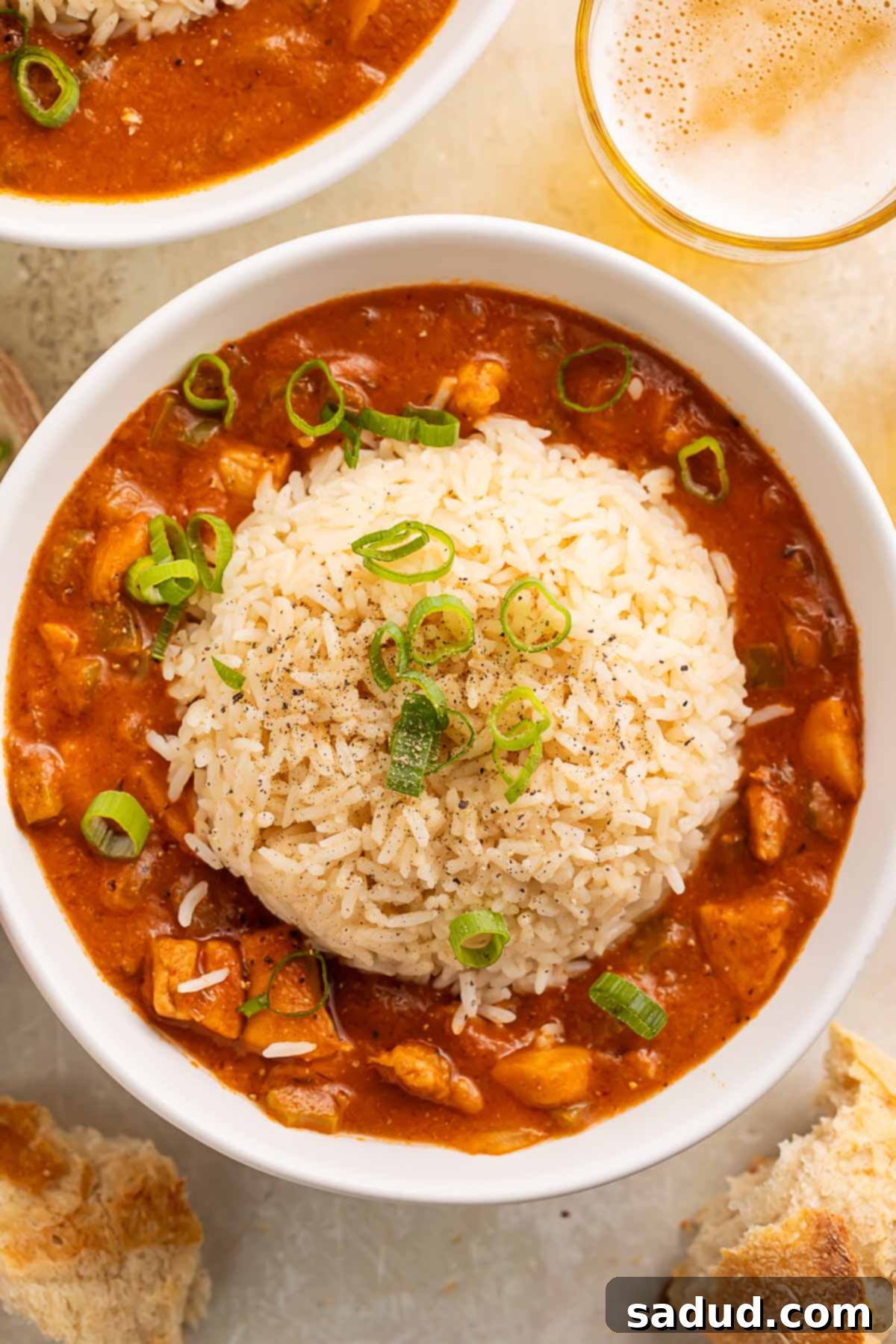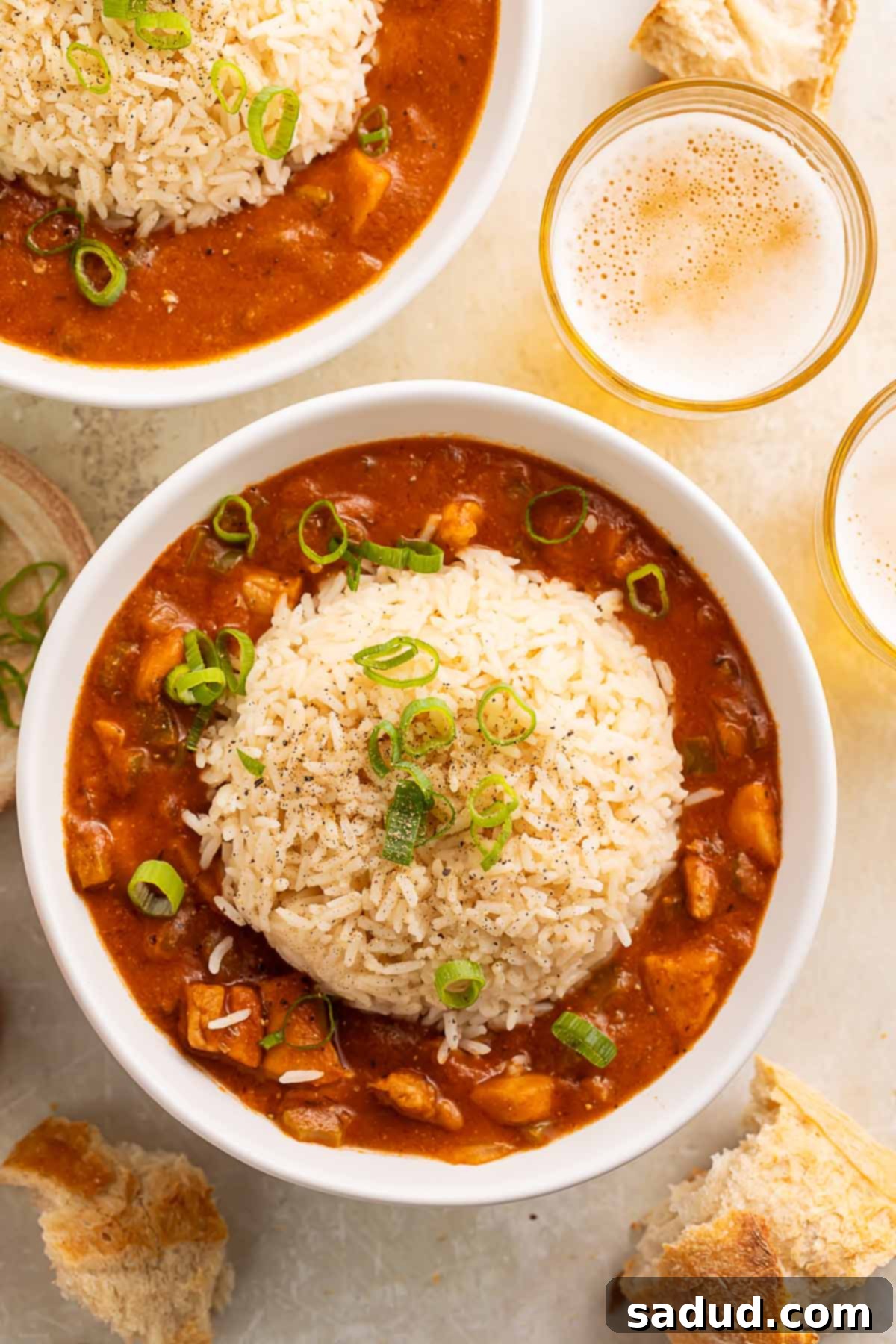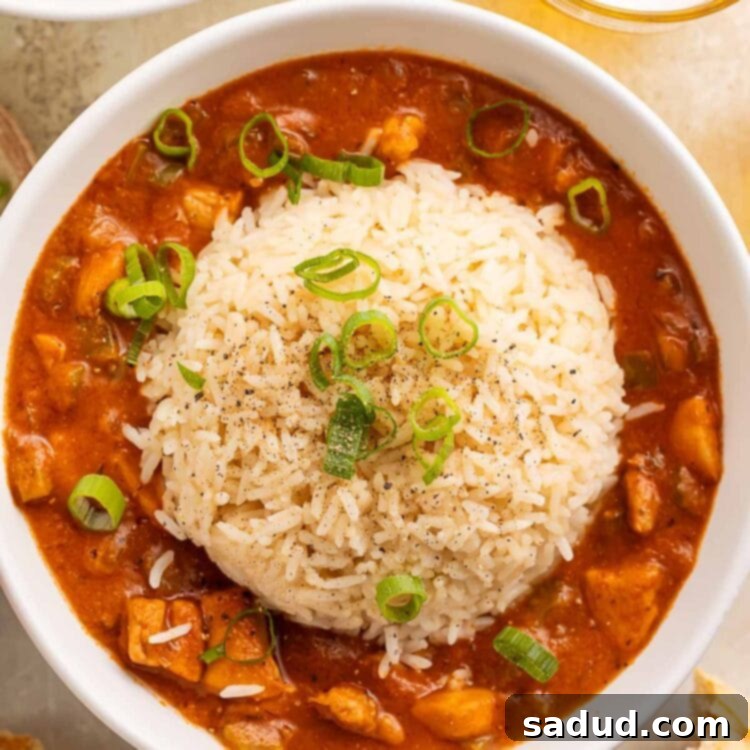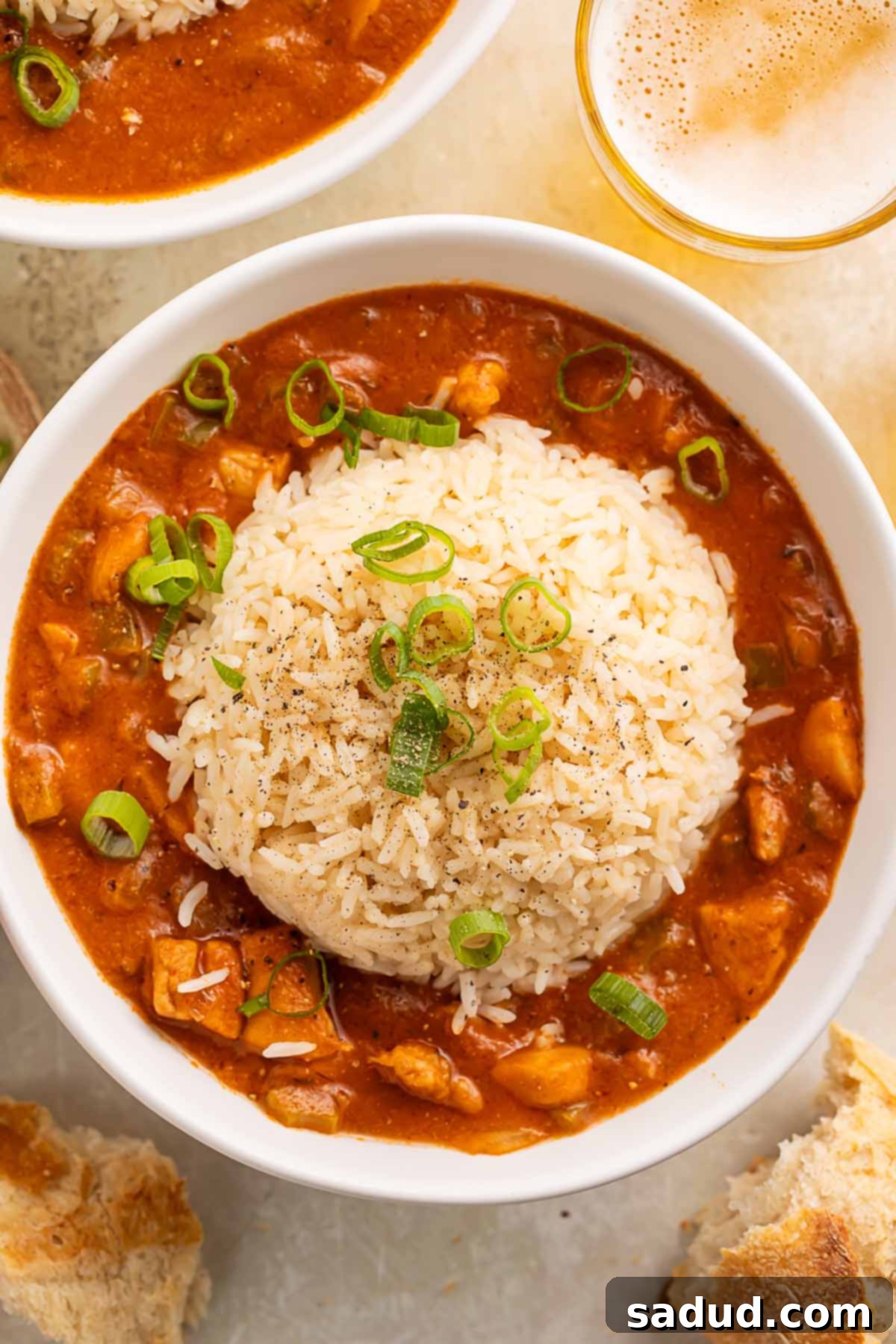Authentic Louisiana Chicken Etouffee: A Hearty Southern Classic Recipe
Embark on a culinary journey to the heart of Louisiana with this classic Chicken Etouffee recipe. Crafted from a meticulously prepared rich roux and the iconic “holy trinity” of Cajun and Creole cooking, this dish promises an explosion of authentic Southern flavors. Tender, juicy chicken thighs are generously smothered in a thick, aromatic, and perfectly spiced sauce, delivering a comforting warmth and an irresistible depth of taste. With just the right amount of heat, each spoonful will transport you to the vibrant kitchens of New Orleans, leaving your bowl spotless and your taste buds craving more. This hearty and soulful etouffee is more than just a meal; it’s an experience, deeply rooted in a rich culinary tradition.

Why You’ll Fall in Love with This Chicken Etouffee Recipe
This Louisiana Chicken Etouffee isn’t just a meal; it’s a celebration of Southern comfort food. Here’s a closer look at what makes this recipe an absolute favorite in our kitchen and why we believe it will become one in yours too:
- An Unforgettable Burst of Flavor and Aromatics: Like its cousin, gumbo, etouffee is a deeply savory Southern dish that truly overflows with complex flavors and enticing aromatics. However, etouffee distinguishes itself with a significantly thicker, velvety sauce and a higher concentration of delicious protein to gravy ratio. This rich, “smothered” consistency, derived from the French word “étouffée,” delivers a more intense flavor profile that clings perfectly to every ingredient. When paired with a mound of fluffy long-grain white rice, this dish transforms into an incredibly satisfying and wholesome meal that will have you savoring every last drop and, quite literally, licking your bowl clean. The interplay of the dark roux, the aromatic holy trinity, and a careful blend of spices creates a symphony of taste that is both robust and incredibly comforting.
- A Versatile Option for Everyone: This chicken etouffee is an exceptional choice, especially if you or your guests have seafood allergies or simply prefer not to consume shrimp or crawfish. While seafood etouffee is a beloved classic, the chicken version stands proudly on its own, offering an equally profound and satisfying experience without compromising on authentic Cajun taste. It’s also an ideal starting point for budding Southern cooks looking to perfect their etouffee technique. Mastering the roux and flavor development with more accessible chicken before moving on to the often more expensive seafood variations is a smart approach. We specifically recommend and utilize boneless, skinless chicken thighs in this recipe because they impart superior flavor and remain wonderfully juicy throughout the cooking process, ensuring tender, melt-in-your-mouth bites of meat. However, if chicken breasts are what you have on hand or prefer, they can certainly be used, just be mindful of adjusting cooking times to prevent them from drying out.
- Comfort Food at Its Finest: There’s something undeniably soulful about a bowl of warm, spiced etouffee. It’s the kind of dish that warms you from the inside out, perfect for cooler evenings or when you simply need a hearty, comforting meal. The rich texture and deep flavors make it incredibly satisfying and fulfilling.
- Beginner-Friendly with Classic Techniques: While the mention of a roux might intimidate some, this recipe breaks down the process, making it approachable for home cooks. It’s an excellent way to learn fundamental Cajun cooking techniques, such as building flavor layers and mastering the roux, which are transferable to many other Southern dishes.
Expert Chef’s Tips for Mastering Your Etouffee
Crafting the perfect chicken etouffee involves a few key techniques and considerations. Follow these expert tips to ensure your dish is as authentic and delicious as possible:
- Do NOT Rush the Roux! This is Crucial. The roux is the soul of your etouffee, providing both its characteristic nutty flavor and its essential thickening power. Making a proper roux requires patience and undivided attention. You must give it ample time, typically 10 to 15 minutes, to develop that beautiful, rich, peanut-butter-like brown coloring. If you cut this process short and don’t allow the flour and butter to darken sufficiently, your etouffee will lack the deep, complex flavor it needs and won’t achieve the desired thick, luscious consistency. More importantly, never, ever walk away from your roux! Just because it takes a few minutes doesn’t mean it’s a hands-off operation. A roux can go from perfect to burnt in a matter of seconds, and a burnt roux will render your entire dish bitter and unusable. Stay by the stove, stir constantly with a wooden spoon or whisk, and watch it like a hawk. The effort is well worth the reward.
- Ensure Uniform Chicken Pieces: Consistency in cooking starts with consistent preparation. It’s vital to cut your chicken thighs into equally-sized 1-inch cubes or chunks. If there’s a significant variation in the size of your chicken pieces, you’ll encounter problems during cooking. Smaller pieces will cook much faster, leading to dry, overcooked chicken, while larger pieces might remain undercooked in the center. Uniform pieces guarantee that every bite of chicken in your etouffee is perfectly cooked, tender, and juicy. Take the extra minute or two to properly size your chicken.
- Master Your Mise en Place: Before you even think about starting your roux, have all your ingredients prepped and measured – this is what chefs call “mise en place.” Chop your holy trinity (celery, bell pepper, onion), measure your spices, and have your chicken stock and other liquids ready. Cajun cooking, especially when making a roux, moves quickly, and you won’t have time to chop or measure once you’ve started. Having everything within arm’s reach will make the cooking process smooth, efficient, and stress-free.
- Control the Heat: Throughout the entire cooking process, especially when making the roux and simmering the vegetables, pay close attention to your stovetop’s heat. Medium heat is typically ideal for roux, allowing it to brown slowly without burning. When sautéing vegetables, medium-high can be used briefly to soften them, but never let anything scorch. Adjust the heat as needed to maintain a gentle simmer for the etouffee sauce, ensuring flavors meld beautifully without overcooking the chicken once it’s returned to the pot.
- Layering Flavors is Key: Authentic etouffee isn’t just about throwing ingredients into a pot; it’s about building layers of flavor. From searing the seasoned chicken to developing the rich roux, sautéing the holy trinity, and then adding the various seasonings and sauces, each step contributes to the final complex taste profile. Don’t skip steps or rush through them. Allow each component to develop its full flavor before adding the next, and remember to taste and adjust seasonings frequently throughout the process.

Understanding the “Holy Trinity” in Cajun & Creole Cuisine
At the heart of almost every savory Cajun and Creole dish, including our delicious chicken etouffee, lies the foundational aromatic blend known as the “Holy Trinity.” This sacred trio consists of chopped onions, celery, and green bell peppers. Much like the French mirepoix (carrots, celery, onions) or Italian soffritto (onions, garlic, celery, carrots), the Holy Trinity provides the essential aromatic base that builds the characteristic depth and flavor of Louisiana cooking. These vegetables are typically sautéed in fat (often butter or oil, or the fat from the roux) until softened, releasing their sweet, pungent, and earthy notes, setting the stage for the rich and complex flavors that follow in dishes like etouffee, gumbo, and jambalaya.
Other New-Orleans-Style Recipes You’ll Love
If you’re a fan of the vibrant and distinct flavors of New Orleans, you’ll be delighted to explore these other delicious recipes that capture the essence of Cajun and Creole cooking. From sweet treats to savory seafood and hearty stews, there’s something here for every palate:
- Gluten Free King Cake
- Keto Gumbo
- Quick & Easy Blackened Shrimp
- New Orleans BBQ Shrimp Po-Boy
- Chicken and Sausage Gumbo
- Seafood Jambalaya
- Shrimp and Grits
- Bananas Foster (from Brennan’s New Orleans)
- Shrimp Remoulade
- Shrimp Gumbo
If you loved this recipe as much as we did, don’t forget to leave us a review below. ★ Follow Easy Healthy Recipes on Pinterest, Facebook, and Instagram, too!
For more delicious recipes, visit our sister sites, 40 Aprons and Easy Cheap Recipes.

Chicken Etouffee
 Cheryl Malik
Cheryl Malik
Print Recipe
Save RecipeSaved!
Ingredients
For the Flavorful Chicken
- 1 pound boneless, skinless chicken thighs approximately 2–3 large chicken thighs, cut into 1-inch cubes
- 1 tablespoon Cajun seasoning salt-free recommended, to allow for better salt control
- 1 tablespoon neutral-flavored oil such as avocado oil, light olive oil, vegetable oil, or refined coconut oil for searing
For the Rich Chicken Etouffee Sauce
- ¼ cup unsalted butter cut into small pieces and at room temperature for easy melting
- ¼ cup all-purpose flour for creating the roux
- ½ cup chopped celery approximately 1 large celery stalk, part of the Holy Trinity
- ½ cup chopped green bell pepper approximately 1 medium bell pepper, another key component of the Holy Trinity
- ½ cup chopped white onion approximately 1 small onion, completing the Holy Trinity
- 4 cups chicken stock low sodium is preferred for better salt control
- 2 tablespoons tomato paste adds depth and a hint of sweetness
- 1 tablespoon Worcestershire sauce for an umami boost
- 1 tablespoon Cajun seasoning salt-free recommended for precise seasoning
- 1 teaspoon garlic powder for an added layer of aromatic flavor
- ¼ teaspoon cayenne pepper adjust to your preferred level of heat
- 1-2 teaspoons hot sauce Louisiana or Crystal brand recommended; add to taste for a final kick
- salt to taste, adjust at the end of cooking
Serving Suggestions
- cooked long-grain white rice essential for serving, a fluffy bed for the rich etouffee
- 1 cup thinly sliced scallions green parts only, approximately 1 bunch, for garnish and a fresh bite
- chopped parsley optional, for a vibrant color and fresh herbaceousness
- crusty bread optional, perfect for soaking up every last drop of the rich sauce
Equipment
-
Cutting board
-
large chef’s knife
-
large, heavy-bottomed saucepan with a tightly fitting lid, essential for even heat distribution and simmering
-
large wooden spoon or spatula for stirring the roux
-
Large bowl for resting the seared chicken
-
Paper towels for cleaning the pan
-
Whisk for incorporating flour into butter smoothly
Instructions
-
Begin by preparing your chicken. Place the 1 pound boneless, skinless chicken thighs on a clean cutting board. Trim away any excess fat or gristle as needed, then carefully cut the chicken into uniform 1-inch cubes or chunks. Uniformity is key here for even cooking.
-
Generously sprinkle the 1 tablespoon of Cajun seasoning evenly over the chicken cubes. Toss the chicken thoroughly to ensure that all sides are coated with the spice blend. Set the seasoned chicken aside to allow the flavors to meld while you prepare your cooking vessel.
-
Position a large, heavy-bottomed saucepan on your stovetop over medium-high heat. Allow the pan to warm up for a few minutes. Once the pan is warm, add the 1 tablespoon of neutral-flavored oil and continue heating the pan until the oil appears hot and shimmery, indicating it’s ready for searing.
-
When the oil is sufficiently hot, carefully place the seasoned chicken pieces into the saucepan in a single, even layer. Avoid overcrowding the pan; work in batches if necessary to ensure a good sear. Sear the chicken undisturbed for 60 to 90 seconds to develop a beautiful crust, then stir the chicken gently. Continue cooking the chicken, stirring occasionally, for an additional 1 to 2 minutes or more, until all sides of the chicken are lightly browned and caramelized. The goal here is to build flavor, not to cook the chicken through.
-
Once seared, transfer the chicken to a large bowl and set it aside for later. Using paper towels, carefully wipe out any residue or excess oil from the saucepan, leaving it clean for the next step. Return the clean saucepan to the heat and reduce the heat setting to medium.
-
Add the ¼ cup of unsalted butter (cut into small pieces for quicker melting) to the saucepan. Allow the butter to melt completely, then add the ¼ cup of all-purpose flour to the pan. Immediately begin whisking the flour into the melted butter until it is fully incorporated, forming a smooth paste with no lumps. This is the beginning of your roux.
-
Continue to cook the roux over medium heat for approximately 10 to 15 minutes. It is absolutely essential to stir frequently and continuously during this process to prevent burning. The roux will gradually change color, darkening from a pale yellow to a rich, deep peanut-buttery brown. This color development is crucial for the depth of flavor in your etouffee. Do not rush this step, as patience here yields the best results.
-
Once your roux has reached the desired color, add the ½ cup of chopped celery, ½ cup of chopped green bell pepper, and ½ cup of chopped white onion (the “Holy Trinity”) to the roux. Stir well to fully incorporate the vegetables into the thick roux. Sauté the vegetables for approximately 5 minutes, stirring frequently, until they have softened and become tender. This step allows their aromatic flavors to infuse into the base of the sauce.
-
Carefully pour the 4 cups of chicken stock into the saucepan. Stir vigorously to incorporate the stock into the roux and vegetables, making sure to scrape the bottom of the pan thoroughly with your spoon to loosen any flavorful bits that may have stuck. This process is called deglazing and adds even more depth to the sauce.
-
Once the chicken stock is fully incorporated and the mixture is smooth, add the 2 tablespoons of tomato paste and 1 tablespoon of Worcestershire sauce. Stir all the ingredients together until the tomato paste and Worcestershire sauce are completely blended into the simmering liquid.
-
Now, it’s time to build the spice profile. Add the additional 1 tablespoon of Cajun seasoning, 1 teaspoon of garlic powder, and ¼ teaspoon of cayenne pepper to the saucepan. Stir thoroughly until all the spices are fully incorporated into the rich liquid, ensuring an even distribution of flavor and heat.
-
Taste the etouffee mixture and adjust the heat to your preference by stirring in 1-2 teaspoons of hot sauce (Louisiana or Crystal brand is highly recommended for authentic flavor). Stir once more to ensure the hot sauce is well-distributed.
-
Allow the mixture to simmer gently over medium heat for approximately 15 minutes, stirring occasionally to prevent sticking. During this time, the sauce will thicken beautifully and the flavors will deepen and meld together. After simmering, taste the mixture again and stir in salt to taste, as desired. Remember to salt gradually until the perfect balance is achieved.
-
Return the previously seared chicken pieces to the saucepan, nestling them into the rich etouffee sauce. Stir gently to ensure the chicken is fully coated. Reduce the heat under the saucepan to low and cover the pan with its lid. Allow the mixture to simmer, covered, for an additional 5 minutes. This final simmer ensures the chicken finishes cooking through and absorbs all the wonderful flavors of the sauce.
-
Once simmering is complete, ladle the warm etouffee generously into individual serving bowls. Place a large, fluffy scoop of cooked long-grain white rice directly in the center of each bowl. For a finishing touch, garnish your etouffee with a sprinkle of 1 cup of thinly sliced scallions (green parts only) and some chopped parsley, if desired, for a pop of color and fresh herbaceousness. Serve warm and enjoy this authentic taste of Louisiana!
Notes
- Chicken Variations: While boneless, skinless chicken thighs are recommended for their superior flavor and moisture retention, boneless, skinless chicken breasts can also be used. If opting for chicken breasts, be sure to reduce their initial searing time in step 4 to prevent them from drying out, as they cook faster than thighs.
- Cajun Seasoning Insight: For optimal flavor control, we highly recommend using a salt-free Cajun seasoning blend if possible. This allows you the freedom to precisely add as much or as little salt as you like throughout the cooking process, ensuring your etouffee is perfectly seasoned to your taste preference. If your Cajun seasoning contains salt, adjust any additional salt accordingly.
- Storage & Reheating: Leftover chicken etouffee can be stored in an airtight container in the refrigerator for up to 3-4 days. To reheat, gently warm on the stovetop over medium-low heat, stirring occasionally, until heated through. You may need to add a splash of chicken stock or water to loosen the sauce as it can thicken considerably when chilled.
Nutrition Information
Number of total servings shown is approximate. Actual number of servings will depend on your preferred portion sizes.
Nutritional values shown are general guidelines and reflect information for 1 serving using the ingredients listed, not including any optional ingredients. Actual macros may vary slightly depending on specific brands and types of ingredients used.
To determine the weight of one serving, prepare the recipe as instructed. Weigh the finished recipe, then divide the weight of the finished recipe (not including the weight of the container the food is in) by the desired number of servings. Result will be the weight of one serving.
